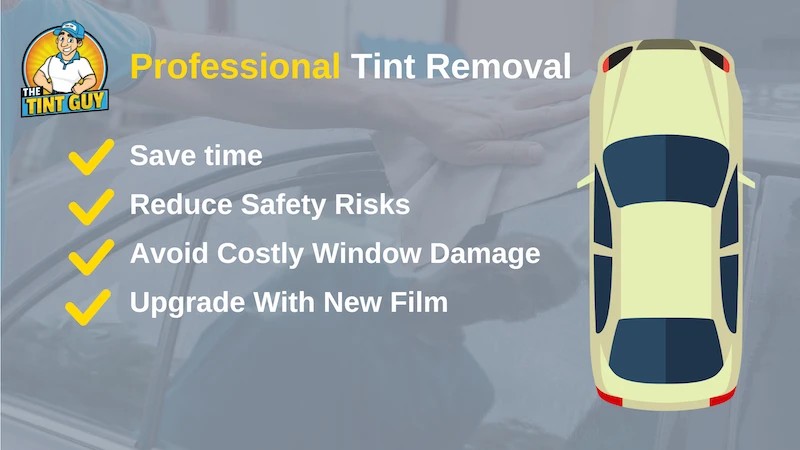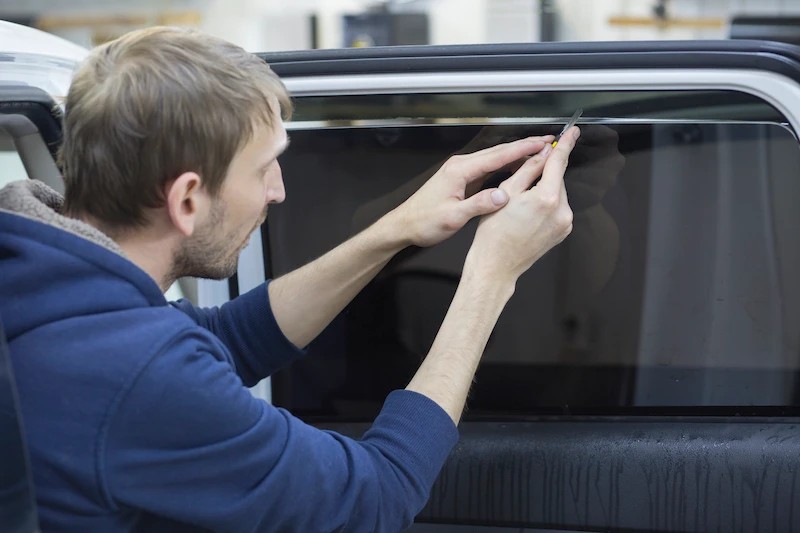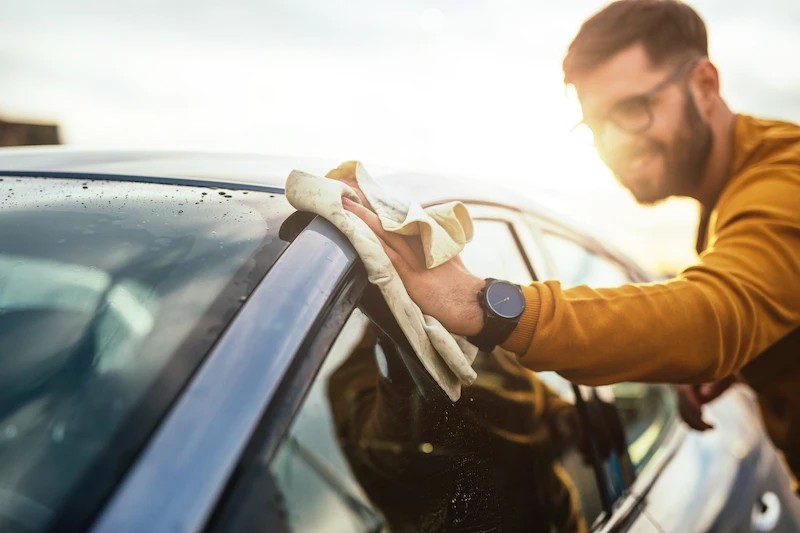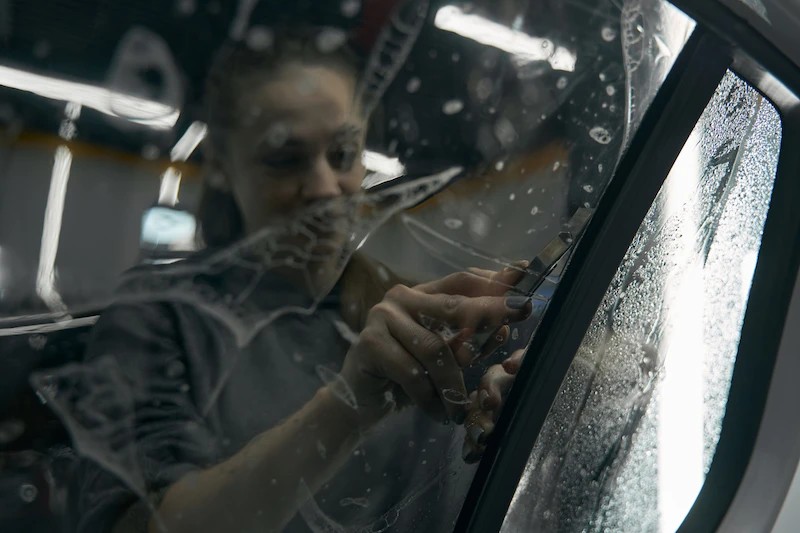Removing tinting from car windows can seem like a daunting task, but with the right knowledge and tools, it’s entirely manageable. At CARS.EDU.VN, we provide you with expert insights and step-by-step guidance to simplify auto care. This guide will walk you through DIY methods and when it’s best to call the pros for window film removal and help you understand adhesive removal and professional tinting services. Discover how to maintain your car’s windows with our expert tips.
1. DIY vs. Professional Tint Removal: Which Is Right for You?
Deciding whether to tackle window tint removal yourself or enlist professional help is a crucial first step. While the DIY approach might seem appealing, especially for budget-conscious car owners, understanding the potential pitfalls and benefits of each method is essential. Let’s weigh the pros and cons to help you make an informed decision.
1.1. The DIY Approach: Empowering or Risky?
Opting for DIY window tint removal can be a rewarding experience for those who enjoy hands-on projects and possess a knack for detail. However, it’s not without its challenges.
Pros:
- Cost Savings: The most apparent advantage is the potential to save money on labor costs. You’ll only need to invest in the necessary tools and materials.
- Flexibility and Control: You have complete control over the process and can work at your own pace, fitting the project into your schedule.
- Learning Experience: Tackling DIY projects can be a fulfilling learning experience, expanding your knowledge of car maintenance.
Cons:
- Time-Consuming: Removing window tint can be a lengthy and tedious process, especially for beginners.
- Risk of Damage: Improper techniques can lead to scratches, cracks, or damage to your car’s windows, potentially resulting in costly repairs.
- Safety Concerns: Working with sharp tools like razor blades and chemicals poses a risk of injury if proper precautions aren’t taken.
- Uneven Results: Achieving a clean, residue-free finish can be challenging without the right expertise and techniques.
1.2. Professional Window Tint Removal: Expertise and Peace of Mind
Hiring a professional window tint removal service offers a convenient and reliable solution, especially for those who value their time and seek peace of mind.
Pros:
- Expertise and Experience: Professionals possess the knowledge, skills, and specialized tools to remove window tint efficiently and safely.
- Reduced Risk of Damage: Trained technicians are less likely to damage your car’s windows during the removal process.
- Time Savings: Professionals can complete the job much faster than DIY enthusiasts, freeing up your time for other priorities.
- Guaranteed Results: Reputable window tinting companies typically offer warranties or guarantees on their work, ensuring your satisfaction.
- Convenience: You can relax and let the professionals handle everything, from preparation to cleanup.
Cons:
- Higher Cost: Professional services come at a higher price compared to DIY methods, primarily due to labor costs.
- Scheduling Considerations: You’ll need to schedule an appointment with a window tinting company, which may require some flexibility in your schedule.
Table 1: DIY vs Professional Tint Removal
| Feature | DIY Removal | Professional Removal |
|---|---|---|
| Cost | Lower initial cost, tool investment required | Higher cost, includes labor and expertise |
| Time | Time-consuming, requires personal effort | Faster, completed by trained technicians |
| Risk of Damage | Higher risk of damaging windows | Lower risk, professionals use safe methods |
| Expertise Needed | Requires research, skill and patience | Minimal, professionals handle the entire process |
| Safety | Requires safety gear and precautions | Generally safer, professionals have experience |
| Convenience | Requires personal involvement and cleanup | More convenient, minimal involvement needed |





Ultimately, the best choice depends on your individual circumstances, budget, and comfort level. If you’re confident in your DIY skills and willing to invest the time and effort, removing window tint yourself can be a satisfying endeavor. However, if you prioritize convenience, safety, and guaranteed results, hiring a professional is the way to go. CARS.EDU.VN always recommends prioritizing safety and consulting professionals when in doubt.
2. Essential Tools and Equipment for DIY Tint Removal
Before embarking on your DIY window tint removal journey, gathering the necessary tools and equipment is crucial for a smooth and successful process. Having the right tools at your disposal will not only make the job easier but also minimize the risk of damaging your car’s windows.
Here’s a comprehensive list of essential tools and equipment:
- Heat Gun: A heat gun is indispensable for loosening the adhesive that bonds the window tint film to the glass. It provides a controlled source of heat to soften the adhesive, making it easier to peel off the film.
- Razor Blade or Scraper: A razor blade or scraper with a sharp, flat edge is essential for lifting the edges of the window tint film and gently peeling it away from the glass.
- Spray Bottle: A spray bottle is needed to apply cleaning solutions and adhesive removers to the window surface.
- Cleaning Solution: A mild cleaning solution, such as soapy water or a specialized glass cleaner, is used to clean the window surface before and after tint removal.
- Adhesive Remover: An adhesive remover, such as isopropyl alcohol, Goo Gone, or a citrus-based cleaner, is crucial for dissolving and removing stubborn adhesive residue left behind after peeling off the tint film.
- Microfiber Cloths: Soft, lint-free microfiber cloths are ideal for wiping down the window surface, removing cleaning solutions, and buffing away adhesive residue without scratching the glass.
- Safety Glasses: Safety glasses are essential to protect your eyes from debris, chemicals, and accidental splashes during the tint removal process.
- Safety Gloves: Safety gloves, such as nitrile or latex gloves, are necessary to protect your hands from chemicals, sharp tools, and potential cuts.
- Face Mask: A face mask helps prevent the inhalation of dust particles and chemical fumes during the tint removal process.
- Tarp or Plastic Sheeting: Tarps or plastic sheeting should be used to cover the surrounding area and protect it from debris, chemicals, and accidental spills.
Table 2: Essential Tools for Tint Removal
| Tool | Purpose | Alternative |
|---|---|---|
| Heat Gun | Softening adhesive for easy film removal | Hair Dryer |
| Razor Blade/Scraper | Lifting and peeling off the tint film | Plastic Scraper |
| Spray Bottle | Applying cleaning and adhesive removal solutions | N/A |
| Cleaning Solution | Cleaning window surface before and after tint removal | Soapy Water |
| Adhesive Remover | Dissolving and removing stubborn adhesive residue | Isopropyl Alcohol |
| Microfiber Cloths | Wiping and buffing window surface without scratching | Soft Cotton Cloth |
| Safety Glasses | Protecting eyes from debris and chemicals | N/A |
| Safety Gloves | Protecting hands from chemicals and cuts | N/A |
| Face Mask | Preventing inhalation of dust and fumes | N/A |
| Tarp/Plastic Sheeting | Protecting surrounding area from debris and spills | Old Sheets/Drop Cloths |
Ensuring you have these essential tools and equipment on hand will set you up for a safe and efficient DIY window tint removal experience. Remember to prioritize safety by wearing protective gear and following the instructions carefully. For more detailed guidance and tips, visit CARS.EDU.VN.
3. Preparing Your Car and Work Area for Tint Removal
Proper preparation is key to a successful and hassle-free window tint removal project. Before you start peeling away at the old film, take the time to prepare your car and work area to minimize mess, prevent damage, and ensure a safe working environment.
3.1. Choosing a Suitable Work Area
Select a well-ventilated area to work in, such as an outdoor space or a garage with the door open. This will help dissipate any chemical fumes and reduce the risk of inhaling dust particles.
3.2. Protecting Your Car’s Interior and Exterior
Cover the interior of your car with tarps or plastic sheeting to protect upholstery, carpets, and other surfaces from adhesive residue, cleaning solutions, and accidental scratches. Pay special attention to covering the dashboard, door panels, and center console.
Apply masking tape around the edges of the windows to protect the paint and trim from scratches and chemical exposure. This will also create a clean edge for peeling off the tint film.
3.3. Gathering Your Supplies and Tools
Organize all your tools and supplies within easy reach to avoid interruptions during the tint removal process. This will also help you stay focused and prevent accidents.
3.4. Donning Protective Gear
Before you begin working, put on your safety glasses, safety gloves, and face mask to protect yourself from debris, chemicals, and potential injuries.
Table 3: Steps for Preparing Your Car and Work Area
| Step | Description |
|---|---|
| 1. Choose a Work Area | Select a well-ventilated space, preferably outdoors or in a garage with open doors, to minimize fume exposure. |
| 2. Protect Car Interior | Cover seats, dashboard, and door panels with plastic sheeting or tarps to prevent adhesive or chemical damage. |
| 3. Tape Edges of Windows | Apply masking tape around the window edges to protect paint and trim from scratches and provide a clean edge. |
| 4. Gather Tools & Supplies | Arrange all tools, cleaning solutions, and safety gear within easy reach to maintain efficiency and safety. |
| 5. Wear Protective Gear | Put on safety glasses, gloves, and a mask to protect against chemicals, debris, and potential injuries during the removal process. |
By following these preparation steps, you’ll create a safe, organized, and efficient workspace, setting the stage for a successful window tint removal project. Remember to consult CARS.EDU.VN for more in-depth guides and expert tips on car maintenance.
4. The Heat Gun Technique: Softening the Adhesive Bond
The heat gun technique is a crucial step in removing window tint from your car. This method involves using a heat gun to soften the adhesive that bonds the tint film to the glass, making it easier to peel off. Applying the heat properly is essential to avoid damaging the glass or leaving behind excessive residue.
4.1. How to Use a Heat Gun Effectively
Start by rolling down the window a few inches to expose the top edge of the tint film.
Hold the heat gun a few inches away from the window surface and move it in a slow, sweeping motion across the tint film. Avoid holding the heat gun in one spot for too long, as this can cause the glass to overheat and potentially crack.
As you heat the film, you should notice the edges starting to curl or bubble. This indicates that the adhesive is softening.
4.2. Alternative Heating Methods
If you don’t have a heat gun, you can use a hair dryer as an alternative. However, keep in mind that a hair dryer may not provide as much heat as a heat gun, so the process may take longer.
Another alternative is a fabric steamer. The steam helps to loosen the adhesive, making it easier to peel off the tint film.
Table 4: Comparing Heating Methods for Tint Removal
| Method | Pros | Cons |
|---|---|---|
| Heat Gun | Effective for softening adhesive quickly | Can overheat glass if not used carefully |
| Hair Dryer | Safer than heat gun, less risk of overheating | Less effective, takes longer to soften adhesive |
| Fabric Steamer | Gentle on glass, effectively loosens adhesive with moisture | Can be messy, requires careful handling to avoid burns from steam |
4.3. Tips for Safe Heating
Always wear safety glasses and gloves when using a heat gun or hair dryer.
Be careful not to overheat the glass, as this can cause it to crack or shatter.
Keep the heat gun or hair dryer moving to distribute the heat evenly.
If you notice the tint film starting to melt or burn, reduce the heat or move the heat source further away.
By following these guidelines, you can effectively use the heat gun technique to soften the adhesive bond and prepare the window tint for removal. For more expert tips and advice on car maintenance, visit CARS.EDU.VN.
5. Lifting and Peeling: Removing the Tint Film
Once you’ve softened the adhesive with a heat gun or alternative method, the next step is to lift and peel the tint film from the window. This process requires patience and a steady hand to avoid tearing the film or damaging the glass.
5.1. Starting the Peel
Use a razor blade or plastic scraper to gently lift a corner of the tint film. Once you have a small section lifted, you can begin peeling the film away from the window.
5.2. Best Practices for Peeling
Peel the film slowly and steadily, pulling it at a shallow angle to minimize the risk of tearing.
If the film is difficult to peel, apply more heat to soften the adhesive further.
Use the razor blade or scraper to gently scrape away any stubborn areas of adhesive.
5.3. Dealing with Difficult Spots
For areas where the tint film is particularly stubborn, you can try using an adhesive remover to help loosen the bond.
Apply the adhesive remover to the area and let it sit for a few minutes before attempting to peel the film again.
Table 5: Troubleshooting Issues During Tint Film Removal
| Issue | Possible Cause | Solution |
|---|---|---|
| Film tearing | Pulling too fast or at a sharp angle | Slow down, use a shallow angle, apply more heat |
| Adhesive sticking | Insufficient heat, old or low-quality adhesive | Apply more heat, use adhesive remover |
| Scratches on glass | Using excessive force with razor blade or scraper | Use a plastic scraper, apply more adhesive remover, be gentle |
5.4. Safety Considerations
Always wear safety glasses and gloves when working with razor blades or scrapers.
Be careful not to cut yourself or damage the window glass.
Dispose of used razor blades properly to prevent accidents.
By following these best practices, you can successfully lift and peel the tint film from your car’s windows, preparing them for the next step: adhesive removal. For more detailed guides and expert tips on car care, visit CARS.EDU.VN.
6. Removing Adhesive Residue: Achieving a Clean Finish
After peeling off the window tint film, you’ll likely be left with a sticky layer of adhesive residue on the glass. Removing this residue is essential for achieving a clean, clear finish. Several methods and products can effectively dissolve and remove stubborn adhesive.
6.1. Recommended Adhesive Removers
- Isopropyl Alcohol: Isopropyl alcohol, also known as rubbing alcohol, is a versatile solvent that can effectively dissolve many types of adhesives. Apply it to the residue, let it sit for a few minutes, and then wipe it away with a clean cloth.
- Goo Gone: Goo Gone is a commercially available adhesive remover that is specifically designed to dissolve sticky residue. Follow the manufacturer’s instructions for best results.
- Citrus-Based Cleaners: Citrus-based cleaners, such as orange oil or lemon oil, are natural solvents that can also dissolve adhesive residue. Apply them to the residue, let them sit for a few minutes, and then wipe them away with a clean cloth.
6.2. Application Techniques
Apply the adhesive remover to the residue using a spray bottle or a clean cloth.
Let the adhesive remover sit for a few minutes to allow it to penetrate and dissolve the adhesive.
Use a clean, lint-free cloth to wipe away the dissolved adhesive.
For stubborn areas, you may need to repeat the process or use a plastic scraper to gently lift the residue.
6.3. Tips for Stubborn Residue
If the adhesive residue is particularly stubborn, try using a combination of heat and adhesive remover.
Apply heat to the residue with a heat gun or hair dryer to soften it, and then apply the adhesive remover.
Let the adhesive remover sit for a few minutes, and then wipe away the dissolved residue with a clean cloth.
Table 6: Comparing Adhesive Removal Methods
| Method | Pros | Cons |
|---|---|---|
| Isopropyl Alcohol | Affordable, readily available, effective for many adhesives | Can be harsh on some surfaces, may require multiple applications |
| Goo Gone | Specifically designed for adhesive removal, effective on stubborn residue | Can be more expensive than other options, may have a strong odor |
| Citrus-Based Cleaners | Natural, environmentally friendly, pleasant scent | May not be as effective on all types of adhesives, can leave an oily residue |
6.4. Safety Precautions
Always wear safety glasses and gloves when working with adhesive removers.
Work in a well-ventilated area to avoid inhaling chemical fumes.
Avoid getting adhesive remover on your car’s paint or interior surfaces.
By following these tips and techniques, you can effectively remove adhesive residue and achieve a clean, clear finish on your car’s windows. For more expert advice on car care and maintenance, visit CARS.EDU.VN.
7. Final Cleaning: Achieving Spotless Windows
Once you’ve removed the adhesive residue, the final step is to clean your car’s windows thoroughly to remove any remaining traces of adhesive remover, dirt, or streaks. This will ensure that your windows are spotless and provide optimal visibility.
7.1. Choosing the Right Cleaning Products
- Glass Cleaner: Use a high-quality glass cleaner that is specifically designed for automotive use. Avoid using household cleaners, as they may contain ammonia or other ingredients that can damage your car’s windows.
- Microfiber Cloths: Use clean, lint-free microfiber cloths to wipe down the windows. Avoid using paper towels, as they can leave behind lint and streaks.
7.2. Cleaning Techniques
Spray the glass cleaner onto the window surface.
Wipe the window with a clean microfiber cloth, using a circular motion.
Use a separate clean, dry microfiber cloth to buff the window to a streak-free shine.
Pay attention to the edges and corners of the window, as these areas can often be missed.
7.3. Tips for Streak-Free Windows
- Work in the Shade: Avoid cleaning your windows in direct sunlight, as this can cause the glass cleaner to dry too quickly and leave streaks.
- Use Two Cloths: Use one cloth to apply the glass cleaner and another to buff the window dry.
- Change Cloths Frequently: Use clean cloths to prevent spreading dirt and grime.
Table 7: Common Window Cleaning Mistakes and How to Avoid Them
| Mistake | Solution |
|---|---|
| Using the wrong cleaner | Use a high-quality glass cleaner specifically designed for automotive use |
| Using dirty cloths | Use clean microfiber cloths and change them frequently |
| Cleaning in direct sunlight | Clean windows in the shade to prevent the cleaner from drying too quickly |
| Not buffing windows dry | Buff windows with a clean, dry microfiber cloth for a streak-free shine |
7.4. Maintaining Clean Windows
- Wash Your Car Regularly: Wash your car regularly to remove dirt and grime from the windows.
- Use a Window Protectant: Apply a window protectant to help repel water and prevent streaks.
- Clean Your Wiper Blades: Clean your wiper blades regularly to ensure they are functioning properly.
By following these cleaning tips and techniques, you can achieve spotless, streak-free windows that provide optimal visibility and enhance the appearance of your car. For more expert advice on car care and maintenance, visit CARS.EDU.VN.
8. Window Tint Removal Cost: DIY vs. Professional
When considering window tint removal, one of the key factors to weigh is the cost. The overall expense can vary significantly depending on whether you choose the DIY route or opt for professional services. Let’s break down the potential costs associated with each approach.
8.1. DIY Tint Removal Costs
The primary appeal of DIY window tint removal lies in its potential cost savings. However, it’s essential to factor in all the necessary expenses to get an accurate picture.
- Tools and Supplies: You’ll need to purchase essential tools and supplies, such as a heat gun, razor blade or scraper, spray bottle, cleaning solution, adhesive remover, microfiber cloths, safety glasses, safety gloves, and a face mask. The cost of these items can range from $30 to $100, depending on the quality and quantity you choose.
- Time Investment: While not a direct monetary cost, the time you spend on DIY tint removal has value. Consider the hours you’ll dedicate to the project and whether that time could be better spent on other activities or earning opportunities.
- Potential for Mistakes: DIY projects come with the risk of errors or accidents. If you damage your car’s windows during the removal process, you’ll need to factor in the cost of repairs or replacements, which can be substantial.
8.2. Professional Tint Removal Costs
Hiring a professional window tint removal service offers convenience and expertise, but it also comes with a higher price tag.
- Labor Costs: The primary cost of professional tint removal is labor. Window tinting companies typically charge an hourly rate or a flat fee per window. The exact cost will vary depending on the company, your location, and the complexity of the job.
- Materials and Supplies: Professional services include the cost of materials and supplies, such as cleaning solutions, adhesive removers, and protective gear.
- Additional Services: Some window tinting companies may offer additional services, such as window cleaning or new tint installation. These services will add to the overall cost.
8.3. Average Cost Estimates
While the exact cost of window tint removal will vary, here are some general estimates to help you budget:
- DIY: $30 – $100 for tools and supplies
- Professional: $60 for all four side windows and $85 for the windshield or rear window.
Table 8: Cost Comparison: DIY vs. Professional Tint Removal
| Cost Factor | DIY Removal | Professional Removal |
|---|---|---|
| Tools and Supplies | $30 – $100 | Included in service fee |
| Labor | Your time (unpaid) | Hourly rate or flat fee per window (higher cost) |
| Potential Repair Costs | Possible if damage occurs | Lower risk of damage, but potential costs included in service fee |
| Total Estimated Cost | $30 – $100 + value of your time | $60 – $85 + (dependent on the shop) |
8.4. Making the Right Choice
Ultimately, the best choice depends on your budget, DIY skills, and comfort level. If you’re on a tight budget and enjoy hands-on projects, DIY tint removal may be a viable option. However, if you value convenience, expertise, and peace of mind, hiring a professional is often the most cost-effective choice in the long run. CARS.EDU.VN recommends weighing these factors carefully to make an informed decision.
9. Replacing Your Film: Upgrade for Enhanced Benefits
Removing old window tint often opens the door for an exciting opportunity: upgrading to a newer, higher-quality film. Modern window tints offer a wide range of benefits, from enhanced UV protection to improved aesthetics. Let’s explore the advantages of replacing your film and how to choose the right one for your needs.
9.1. Benefits of Upgrading Window Tint
- Enhanced UV Protection: High-quality window tints can block up to 99% of harmful ultraviolet (UV) rays, protecting your skin and preventing fading of your car’s interior.
- Improved Heat Rejection: Advanced tinting technologies can significantly reduce heat buildup inside your car, keeping you cooler and more comfortable during hot weather.
- Increased Privacy: Window tint provides an added layer of privacy, shielding you and your passengers from prying eyes.
- Glare Reduction: Tinted windows can reduce glare from the sun and headlights, improving visibility and reducing eye strain.
- Enhanced Appearance: Window tint can give your car a sleek, stylish look, enhancing its overall aesthetic appeal.
9.2. Types of Window Tint Films
- Dyed Films: Dyed films are the most affordable option, but they offer limited heat rejection and UV protection.
- Metallic Films: Metallic films contain tiny metallic particles that reflect heat and UV rays. They offer better performance than dyed films but can interfere with electronic signals.
- Carbon Films: Carbon films use carbon particles to absorb heat and UV rays. They provide excellent performance without interfering with electronic signals.
- Ceramic Films: Ceramic films are the highest quality option, offering superior heat rejection, UV protection, and glare reduction. They are also non-reflective and won’t interfere with electronic signals.
Table 9: Comparison of Window Tint Film Types
| Film Type | UV Protection | Heat Rejection | Glare Reduction | Electronic Interference | Cost |
|---|---|---|---|---|---|
| Dyed | Low | Low | Low | None | Low |
| Metallic | Medium | Medium | Medium | Possible | Medium |
| Carbon | High | High | High | None | High |
| Ceramic | Excellent | Excellent | Excellent | None | Excellent |
9.3. Choosing the Right Tint Film
When selecting a new window tint film, consider your priorities and budget. If you’re primarily concerned with UV protection and heat rejection, a carbon or ceramic film is an excellent choice. If you’re on a tight budget, a dyed or metallic film may be more suitable.
Also, check your local laws and regulations regarding window tint darkness. Most states have restrictions on how dark window tint can be, so be sure to choose a film that complies with these laws.
9.4. Professional Installation
While it’s possible to install window tint yourself, professional installation is highly recommended. Professional installers have the expertise and equipment to ensure a flawless finish, free from bubbles, creases, or other imperfections.
By upgrading to a new, high-quality window tint film, you can enhance your driving experience, protect your car’s interior, and improve its overall appearance. CARS.EDU.VN offers expert advice and resources to help you make the right choice.
10. Why Choose CARS.EDU.VN for Your Auto Needs?
At CARS.EDU.VN, we understand the challenges car owners face when seeking reliable information and services. From finding trustworthy repair shops to keeping up with routine maintenance, the process can be overwhelming. That’s why we’ve created a comprehensive platform to address your needs and empower you with the knowledge and resources to make informed decisions.
10.1. Expert Information and Guidance
Our website offers a wealth of expert articles, guides, and tutorials covering a wide range of automotive topics. Whether you’re looking for tips on removing window tint, advice on choosing the right car insurance, or step-by-step instructions for performing basic maintenance tasks, you’ll find the information you need at CARS.EDU.VN.
10.2. Addressing Customer Challenges
We recognize the common challenges car owners face, such as:
- Difficulty finding trustworthy and quality car repair services
- Lack of knowledge regarding routine car maintenance to prevent major issues
- Uncertainty when selecting a car model or brand that fits their needs and budget
- Trouble fixing minor car problems on their own
- Desire to stay updated on the latest automotive technologies and expert car reviews
10.3. Services Tailored to Your Needs
CARS.EDU.VN provides services to assist with:
- Detailed information on car care and repair services
- Easy-to-understand guides on routine car maintenance
- In-depth reviews and comparisons of various car models and brands
- Guides to help you troubleshoot simple car issues
- Updates on the latest car news and technologies
10.4. Building Trust and Reliability
We are committed to providing accurate, unbiased, and up-to-date information. Our team of automotive experts rigorously researches and reviews all content to ensure its accuracy and reliability. We also welcome feedback from our users to continuously improve our platform and provide the best possible experience.
10.5. Comprehensive Automotive Solutions
Whether you’re a seasoned car enthusiast or a first-time car owner, CARS.EDU.VN has something to offer. From expert advice to practical tips, we’re here to help you navigate the world of car ownership with confidence. Visit our website today to explore our comprehensive resources and discover how CARS.EDU.VN can help you with all your automotive needs.
Considering removing or replacing your car window tint? Visit CARS.EDU.VN today for expert advice, detailed guides, and trusted service recommendations. We’re here to help you make informed decisions and keep your car looking its best. Contact us at 456 Auto Drive, Anytown, CA 90210, United States, or reach out via WhatsApp at +1 555-123-4567. Let CARS.EDU.VN be your trusted partner in car care.
Frequently Asked Questions (FAQ) About Removing Car Window Tint
Here are some frequently asked questions about removing car window tint, along with detailed answers to help you navigate the process:
1. Is it legal to remove window tint from my car?
Yes, it is generally legal to remove window tint from your car. However, be sure to check your local laws and regulations regarding window tint darkness before installing new tint.
2. Can I remove window tint myself, or should I hire a professional?
You can remove window tint yourself, but it’s important to consider the risks and challenges involved. If you’re not comfortable working with sharp tools or chemicals, or if you’re concerned about damaging your car’s windows, hiring a professional is the best option.
3. What tools and materials do I need to remove window tint?
The essential tools and materials for removing window tint include a heat gun, razor blade or scraper, spray bottle, cleaning solution, adhesive remover, microfiber cloths, safety glasses, safety gloves, and a face mask.
4. How do I soften the adhesive on window tint?
The most effective way to soften the adhesive on window tint is to use a heat gun. Apply heat to the film in a slow, sweeping motion until the edges start to curl or bubble.
5. What’s the best way to remove adhesive residue from car windows?
Several adhesive removers can effectively remove adhesive residue from car windows, including isopropyl alcohol, Goo Gone, and citrus-based cleaners.
6. How much does it cost to have a professional remove window tint?
The cost of professional window tint removal varies depending on the company, your location, and the complexity of the job. Generally, you can expect to pay around $60 for all four side windows and $85 for the windshield or rear window.
7. Can removing window tint damage my car’s windows?
Yes, improper tint removal techniques can damage your car’s windows. Using excessive force with a razor blade or scraper can scratch the glass, and overheating the glass can cause it to crack or shatter.
8. What are the benefits of replacing old window tint with new film?
Upgrading to a new, high-quality window tint film can provide enhanced UV protection, improved heat rejection, increased privacy, glare reduction, and an enhanced appearance for your car.
9. How do I clean my car’s windows after removing window tint?
To clean your car’s windows after removing window tint, use a high-quality glass cleaner and clean, lint-free microfiber cloths. Avoid using household cleaners or paper towels, as they can leave streaks and residue.
10. Where can I find more information and resources about car care and maintenance?
Visit cars.edu.vn for expert articles, guides, and tutorials covering a wide range of automotive topics. We’re here to help you navigate the world of car ownership with confidence.

